Welcome to Riverside Native Trees and Nursery
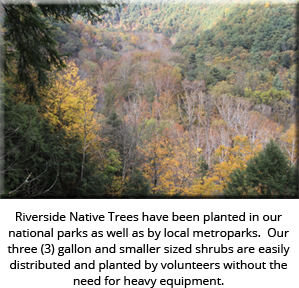 Thank you very much for visiting Riverside Native Trees and Nursery. We started this business in 2005 to provide restoration professionals, landscapers and homeowners with high quality native nursery stock. Back then the problem was that while there were many beautiful native trees and shrubs worthy of being grown they were often hard to find and not many species were available. Today we are working to fix that by offering a large number of beautiful native tree and shrub species grown from seeds collected right here in central Ohio. Riverside Native Trees and Nursery grows local provenance trees and shrubs. That is to say that our plants have “local genetics” and are thus best suited for our soil types and climate. Each tree and shrub we grow has seed collection data prominently displayed on the page for that species. Our goal is to provide you with high quality nursery stock, good information to help plants grow as rapidly as possible, landscaping hints to situate them in your application and, finally, good customer service before and after the sale.
Thank you very much for visiting Riverside Native Trees and Nursery. We started this business in 2005 to provide restoration professionals, landscapers and homeowners with high quality native nursery stock. Back then the problem was that while there were many beautiful native trees and shrubs worthy of being grown they were often hard to find and not many species were available. Today we are working to fix that by offering a large number of beautiful native tree and shrub species grown from seeds collected right here in central Ohio. Riverside Native Trees and Nursery grows local provenance trees and shrubs. That is to say that our plants have “local genetics” and are thus best suited for our soil types and climate. Each tree and shrub we grow has seed collection data prominently displayed on the page for that species. Our goal is to provide you with high quality nursery stock, good information to help plants grow as rapidly as possible, landscaping hints to situate them in your application and, finally, good customer service before and after the sale.
Native trees and shrubs are experiencing a renaissance of sorts right now in the nursery industry. Many people are realizing they play an important role in the environment and the home landscape. For example, native trees and shrubs are used by hundreds of species of butterflies and moths as larval food plants. If you don’t plant natives then insects will look elsewhere for food and shelter. Birds and other natural predators are, in turn, attracted to your landscape looking for this rich food source. They spend more time foraging and being visible in your landscape which is what people want.
Exotic species of trees and shrubs cannot fulfill the roles native trees and shrubs play because insect and other animals are not adapted to using them. Exotics are nearly useless to the larval stages of insects and other animals. While many exotics may provide a nectar source for adult insects this is only for a short period of time when the plant is in bloom. How much better it would be if you could provide food for caterpillars and other juvenile insect stages thus ensuring their presence in your landscape for weeks or months as they mature through their life cycle. Caterpillars do not pose a threat to your native trees and shrubs and are an interesting bonus to share with children and grandchildren. As our own kids grew up there were always Monarch caterpillars in jars and Cecropia and Polyphemus moths being raised on the back deck. What a treat it was to see them emerge as adults and what a great learning experience for children!
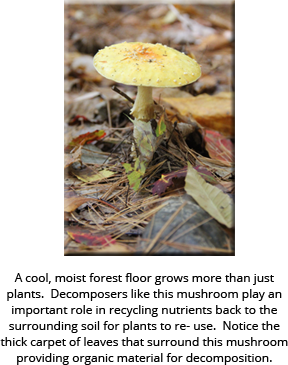
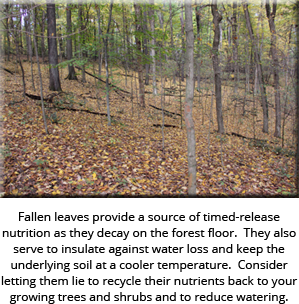
How to use this information
Clinics
We have written a series of short “clinics” on subjects that are important to the health and performance of your trees and shrubs. These should be reviewed before and after purchase. They are in pdf format so they can be printed and used in the field. From the time you get your plants home until they are well established in your landscape the information contained in these sheets will help you make decisions that will encourage and accelerate growth. Please pay particular attention to the clinic on fertilizing as this is the single best thing you can do to promote maximum growth. Coming in a close second is proper pruning. Trees sometimes need to be forced to grow the right way. A little bit of selected pruning can ensure that the tree grows best in the long run.
Clinic topics include:
- Bareroot vs True Container Grown vs Balled and Burlap Trees
- Site Selection and Planting
- Fertilizing for optimal growth
- Pruning for optimal growth
- Staking Trees and Re-establishing a Leader
- Planting for Wildlife
Newsletters
We are also planning on writing informational newsletters about the different species we offer and having them sent via email and archived here in the website. These newsletters would include information on care, native ranges, what insect species use them as host plants, and other information to help you enjoy them fully. If you would like to be added to our email list please contact me at ekapraly@gmail.com. Please note that we will not sell or otherwise give your email address to anyone. If you have other topics that you think would make for a good newsletter please let me know.
What to Buy and Why?
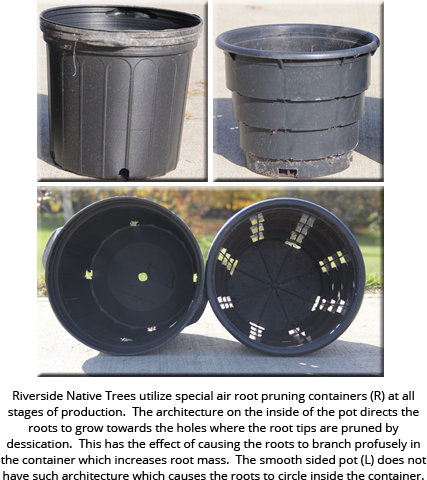 The ideal tree or shrub is a small (3 – 10 gallon-sized) native plant grown from locally collected seeds in a root pruning container for at least a season or two (depending on the container size) All container grown trees are not created equal and we want to distinguish ours from the others. Riverside Native Trees and Shrubs grows only True Container Grown® plants. We use specially molded plastic pots and bags at all stages of production that train and prune the growing root. The effect of this root pruning is to increase the overall quality and root mass of the plant. More root mass means better absorption of water and nutrition before, during and after transplanting to help ensure survival.
The ideal tree or shrub is a small (3 – 10 gallon-sized) native plant grown from locally collected seeds in a root pruning container for at least a season or two (depending on the container size) All container grown trees are not created equal and we want to distinguish ours from the others. Riverside Native Trees and Shrubs grows only True Container Grown® plants. We use specially molded plastic pots and bags at all stages of production that train and prune the growing root. The effect of this root pruning is to increase the overall quality and root mass of the plant. More root mass means better absorption of water and nutrition before, during and after transplanting to help ensure survival.
Trees grown in smooth sided containers or that are balled and burlap have significant risks associated with them because of inherent root damage or malformation during their production. Please see our clinic on ball and burlapped trees vs True Container Grown trees for further information.
What products do we offer?
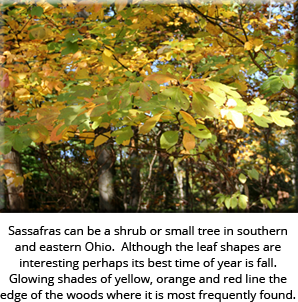 We primarily grow two products; a smaller container called a band pot with overall dimensions of 3-5/8” X 3-5/8” X 6” with a volume of approximately 1.25 qt. Seedlings in band pots are in the 1-2’ range depending on the species. Some, like hickories and buckeyes, are slow growers and may only be 6-12” tall. On each species page of the website there is a note icon that provides further information on the current size of our band pot material. Please see that information to make the most informed choices when ordering. These can be ordered online and easily shipped. We would plant these seedlings to grow into our own 3 gallon trees so you are assured that they are top quality plants. Eight (8) fit conveniently in a long tall shipping box although any number can be purchased.
We primarily grow two products; a smaller container called a band pot with overall dimensions of 3-5/8” X 3-5/8” X 6” with a volume of approximately 1.25 qt. Seedlings in band pots are in the 1-2’ range depending on the species. Some, like hickories and buckeyes, are slow growers and may only be 6-12” tall. On each species page of the website there is a note icon that provides further information on the current size of our band pot material. Please see that information to make the most informed choices when ordering. These can be ordered online and easily shipped. We would plant these seedlings to grow into our own 3 gallon trees so you are assured that they are top quality plants. Eight (8) fit conveniently in a long tall shipping box although any number can be purchased.
The 3 gallon (trade) container trees are generally 4-6 feet tall and have a 5/8” to 3/4” caliper trunk near the soil line.
Won’t it take forever to grow into a shade tree?
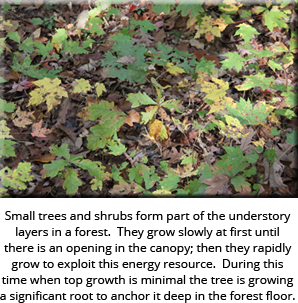 No! Transplanting small (3-10 gallon) True Container Grown® trees provides a cost effective and easily workable task for a homeowner that will result in beautiful, mature trees in just a few short years. Some homeowners may balk at the notion of planting a 5’ tree in their yard because, in their opinion, it is too small. But, consider the following: In the research we conducted preparing for the nursery business, one author, a professor at a major university who specializes in woody plant production offered the following seemingly unbelievable statement. He said that given 5 years, a 5’ true container grown tree (which costs $20 at Riverside Native Trees), could catch up in size to a 2 to 3”caliper balled and burlap tree (cost ranging from $200 to $300) within 5 years! The author’s statement is absolutely true, and if you’d like to see it for yourself, stop by and see our test trees including several species of oaks that were planted several years ago. One particular Bur Oak started out as a 5’ broomstick with not a single branch and only ¾” in caliper at the base grown in our 3 gallon container. Now, 5 years later, it is 15’+ tall with a 4”+ caliper trunk at the base. It is planted in full sun and has branches all around the trunk. I eagerly anticipate that it will grow into a mighty Bur Oak like the ones seen in old fields with big round crowns and huge spreading branches full of character. We have similar success stories for Red Oaks, Chinkapin Oaks, Black Oaks and Swamp White Oaks. For the $300 or more you would spend on one 3” caliper balled and burlap tree you could buy 15 smaller trees of various species from Riverside Native Trees and in 5 years they would be equal in size and you would be well on your way to having a forested landscape.
No! Transplanting small (3-10 gallon) True Container Grown® trees provides a cost effective and easily workable task for a homeowner that will result in beautiful, mature trees in just a few short years. Some homeowners may balk at the notion of planting a 5’ tree in their yard because, in their opinion, it is too small. But, consider the following: In the research we conducted preparing for the nursery business, one author, a professor at a major university who specializes in woody plant production offered the following seemingly unbelievable statement. He said that given 5 years, a 5’ true container grown tree (which costs $20 at Riverside Native Trees), could catch up in size to a 2 to 3”caliper balled and burlap tree (cost ranging from $200 to $300) within 5 years! The author’s statement is absolutely true, and if you’d like to see it for yourself, stop by and see our test trees including several species of oaks that were planted several years ago. One particular Bur Oak started out as a 5’ broomstick with not a single branch and only ¾” in caliper at the base grown in our 3 gallon container. Now, 5 years later, it is 15’+ tall with a 4”+ caliper trunk at the base. It is planted in full sun and has branches all around the trunk. I eagerly anticipate that it will grow into a mighty Bur Oak like the ones seen in old fields with big round crowns and huge spreading branches full of character. We have similar success stories for Red Oaks, Chinkapin Oaks, Black Oaks and Swamp White Oaks. For the $300 or more you would spend on one 3” caliper balled and burlap tree you could buy 15 smaller trees of various species from Riverside Native Trees and in 5 years they would be equal in size and you would be well on your way to having a forested landscape.
Fertilizing and occasional light pruning is the key so be sure to see our clinics on those subjects!
When to Plant
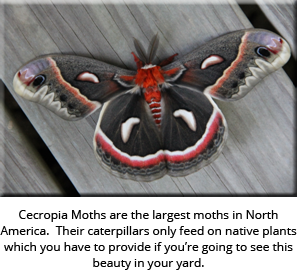 Fall and spring are the best time to plant because moisture levels are higher and rain is more predictable. If, however, you have the time and ability to water they can be planted at any time; even in the summer. The increased root mass of our True Container Grown trees helps the tree absorb more moisture but watering from time to time when it is dry is encouraged. Our larger metroparks customers routinely plant after Thanksgiving. Their thinking is that the tree is dormant by then and its water requirments will be at a minimum. Planting now would allow the tree to grow new roots as soon as the soil warms up by a few degrees in early spring. The only drawback here is that in some years an early freeze may make the soil unworkable.
Fall and spring are the best time to plant because moisture levels are higher and rain is more predictable. If, however, you have the time and ability to water they can be planted at any time; even in the summer. The increased root mass of our True Container Grown trees helps the tree absorb more moisture but watering from time to time when it is dry is encouraged. Our larger metroparks customers routinely plant after Thanksgiving. Their thinking is that the tree is dormant by then and its water requirments will be at a minimum. Planting now would allow the tree to grow new roots as soon as the soil warms up by a few degrees in early spring. The only drawback here is that in some years an early freeze may make the soil unworkable.
Native trees and shrubs offer homeowners a beautiful alternative to less hardy, exotic woody plants. Their beauty may be showy, as in a blaze of fall color, or subtle as in the bronze and purple new growth of oaks early in spring. Their usefulness to insects and other animals is unmatched; yet they are so well adapted to one another that rarely does the insect hurt the plant. One of the easiest things we can do to help reduce habitat loss is plant native plants in our own yards. We will be rewarded with landscaping that is low maintenance, attractive and useful to wildlife.